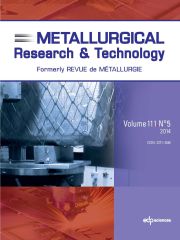Article contents
The reactivity of 316L stainless steel in 55%Al-Znbath
Published online by Cambridge University Press: 01 August 2013
Abstract
Static immersion experiments were conducted to assess the reactivity of austeniticstainless steel grade 316L in contact with molten 55%Al-Zn alloys. The static immersiontests were carried out at bath temperatures of 600 to 650 °C and continuous immersiontimes of 24 to 645 h. The level of reactivity was assessed by measuring the alloy layerthickness that formed on the test coupons after the immersion experiments. The reaction of316L in contact with molten 55%Al-Zn bath results in the formation of two distinct alloylayers on the surface of the steel: one alloy layer forms adjacent to the steel surface(designated “alloy layer 1”) and the other formed between alloy layer 1 and the bath(designated “alloy layer 2”). Characterization of the nature of the alloy layers wascarried out by optical and scanning electron microscopy. Analyses of the chemicalcomposition of alloy layer 1 by SEM/EDS (and taking into account the Al/(Fe + Cr + Ni)ratio) suggest that the alloy layer is most likely based on FeAl2 intermetallicphase. Alloy layer 2, on the other hand, consists of modified ø5c (the normaldross intermetallic phase modified by the substitution of Fe by Cr). After 27 days ofcontinuous immersion at 600 °C, the 316L sample immersed in 55%Al-Zn bath had a totalalloy layer thickness of 423 ¯m. The alloy layer growth is diffusion controlled andfollows a parabolic rate law: at bath temperatures of 600 to 650 °C and continuousimmersion times of up to 27 days, the alloy layer thickness increases approximately withthe square root of immersion time. The parabolic rate constants for the total alloy layerthickness growth were: 2.84 × 10-7 m.s−1/2 at 600 °C,3.34 × 10-7 m.s−1/2 at 615 °C and 6.76 × 10-7m.s−1/2 at 650 °C. Growth of the alloy layers takes place predominantly atthe interface between alloy layer 1 and alloy layer 2, and in part at the substrate/alloylayer 1 interface. The growth of alloy layer 2 is dominated by the inward diffusion ofaluminium, while both inward diffusion of aluminium and outward diffusion of iron arebelieved to play a role in the formation of alloy layer 1.
Keywords
- Type
- Research Article
- Information
- Copyright
- © EDP Sciences 2013
References
- 6
- Cited by


